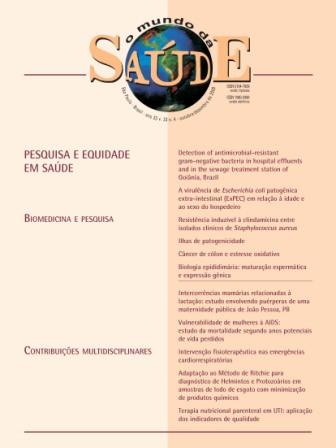Detection of antimicrobial-resistant gram-negative bacteria in hospital effluents and in the sewage treatment station of Goiânia, Brazil
DOI:
https://doi.org/10.15343/0104-7809.20094385391Keywords:
Antimicrobial-resistant gram-negative bacteria, Dissemination of resistant pathogens – environment, HospitalsAbstract
The emergence of antimicrobial-resistant genes and the indiscriminate use of antibiotics contribute to the dissemination of resistant
pathogens in the environment. The objective of the present study was to isolate Pseudomonas aeruginosa, Acinetobacter spp., Klebsiella
pneumoniae and Escherichia coli from the sewage effluents of 10 hospitals located in Goiânia, Brazil, and from the sewage treatment station
of the city, to determine their susceptibility profile and investigate their resistance mechanisms. The isolates from water samples were identified
by biochemical tests and confirmed using API 20E (BioMerieux). Susceptibility profiling was performed by disc diffusion in accordance with the
methodology established by the National Committee for Clinical Laboratory Standards. Extended-spectrum β-lactamase (ESBL) detection was
carried out by the disk approximation method using phenotypic tests. Sixty-seven microorganisms were isolated and identified, including E. coli
10 (14,92%), K. pneumoniae 10 (14,92%), P. aeruginosa 3 (4,47%) and A. baumannii 1 (1,49%). Of the E. coli strains, 100% were resistant to
aztreonam, 40% to ampicillin, 30% to piperacillin, 20% to ciprofloxacin and 10% to gentamicin. None of the bacterial strains produced ESBL or
carbapenems. Of the P. aeruginosa strains, 100% were resistant to ampicillin-sulbactam, while 100% had intermediate resistance to gentamicin.
Strains of K. pneumoniae were resistant to ampicillin (70%) and to piperacillin (20%); additionally, 50% showed intermediate resistance
to piperacillin. Total resistance was not found in any of the isolates of A. baumannii, which showed intermediate resistance to aztreonam and
ceftriaxone. Overall, resistance rates were low in the isolates of E. coli, P. aeruginosa, K. pneumoniae and A. baumannii.






























